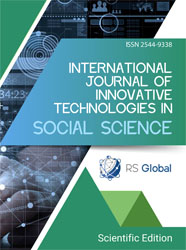THE IMAGE OF A WOMAN IN FOLKLORE AS A FOLK TRADITION
Abstract
This study explores the multifaceted portrayal of women in folklore, focusing on their roles as creators, transmitters, and subjects of oral traditions. Employing a feminist folklore approach, the research aims to elucidate the complex dynamics of gender, power, and representation within folkloric narratives. The methodology combines extensive literature review, comparative analysis of folkloric texts across various Turkic cultures, and critical interpretation informed by feminist theory. The findings reveal that while women's folklore often reflects the dominant patriarchal values, it also serves as a medium for expressing female solidarity, subverting gender norms, and asserting women's agency. The study highlights the significance of women's oral traditions as a vital source for understanding their lived experiences, cultural contributions, and strategies of resistance in maledominated societies. The research contributes to the growing body of feminist folklore scholarship and underscores the importance of integrating women's perspectives into the mainstream folklore discourse. Further research is needed to explore the regional variations, historical transformations, and contemporary adaptations of women's folkloric practices.
References
Abadan, N. (1961). The Representation of Women in Turkish Folk Stories. Journal of American Folklore, 74(293), 241-249.
Aça, B. (2010). The Motif of Humiliated Wife in the Turkic Epic Tradition. Acta Orientalia Academiae Scientiarum Hungaricae, 63(3), 259-268.
Alakbar, L. (2018). Women's Empowerment in Azerbaijani and Turkic Folklore: A Comparative Analysis. Journal of Azerbaijani Studies, 21(1), 55-72.
Bars M.E. (2008). Horse, woman, weapon in «Koroğlu» epic. Turkish Studies - International Periodical for the Languages, Literature and History of Turkish or Turkic. №3(2), 164-178.
Bars M.E. (2014). The female type in the epic of “Ak kagan”. International Journal of Turkish Literature, Culture and Education. Issue: 3/3, 94-111.
Bascom W. (1965). “Four Functions of Folklore”. Alan Dundes (ed.), The Study of Folklore. Englewood Cliffs, NJ, 279-298.
Başgöz, İ. (1998). Turkish Folklore and Oral Literature: Selected Essays. Bloomington: Indiana University Press.
Beydili C. (2003). Turkish mythological dictionary. Baku: Elm, 418 p.
Çobanoğlu, Ö. (2000). Âşık Tarzı Kültür Geleneği ve Destan Türü. Ankara: Akçağ Yayınları.
Ergin M. (1964). Dede Korkut book. Ankara: TDK Publications, 217 p.
Ergün M. (2006). Şor heroic epics. Ankara: Akçağ Publications, 488 p.
Farrer, C. R. (Ed.). (1975). Women and Folklore. Austin: University of Texas Press.
Fedakâr, S. (2016). The Image of Women in Turkish Folk Tales. International Journal of Language Academy, 4(4), 100-111.
Gülbahar, F. (2018). A Feminist Reading of the Representation of Women in the Azerbaijani Epic "Kitabi-Dada Gorgud". Journal of Turkic Studies, 42(1), 95-114.
Habibli, A. (2019). Azerbaijani Women in Folklore and Literature: A Historical Overview. Khazar Journal of Humanities and Social Sciences, 22(4), 56-71.
Harding S. (1987). Feminism and Methodology. Social Science Issues, Bloomington and Indianapolis.
Ismatullaeva, Z. (2002). Women in Uzbek Folklore. Folklore, 113(2), 171-185.
Kafesoglu I. (2012). Turkish National Culture. Istanbul: Ötüken Publication, 454 p.220.
Kandiyoti, D. (1988). Bargaining with Patriarchy. Gender & Society, 2(3), 274-290.
Kendirbaeva, G. (1999). We are Children of Alash... The Kazakh Intelligentsia at the Beginning of the 20th Century in Search of National Identity and Prospects of the Cultural Survival of the Kazakh People. Central Asian Survey, 18(1), 5-36.
Koç Y. (2017). Traces of alpine female type from Banu Çiçek to Gülcemal. Journal of Turkish language and literature №3(2), 147-154.
Korogly K.G. (1983). Interrelations of the epic of the peoples of Central Asia, Iran and Azerbaijan. M.: Nauka, 336 p.
Mirzaoğlu, G. (2016). The Representation of Women in the Kyrgyz Epic "Manas". Bilig, 76, 207-230.
Öztürk, S. (2006). The Changing Image of Women in Turkish Folk Literature. Folklore, 117(1), 38-47.
Qarabagli, A. (2015). The Role of Women in the Preservation and Transmission of Azerbaijani Folklore. Folklore, 126(2), 156-172.
Views:
1362
Downloads:
375
Copyright (c) 2024 Aslanova Gulnara Chingiz

This work is licensed under a Creative Commons Attribution 4.0 International License.
All articles are published in open-access and licensed under a Creative Commons Attribution 4.0 International License (CC BY 4.0). Hence, authors retain copyright to the content of the articles.
CC BY 4.0 License allows content to be copied, adapted, displayed, distributed, re-published or otherwise re-used for any purpose including for adaptation and commercial use provided the content is attributed.











